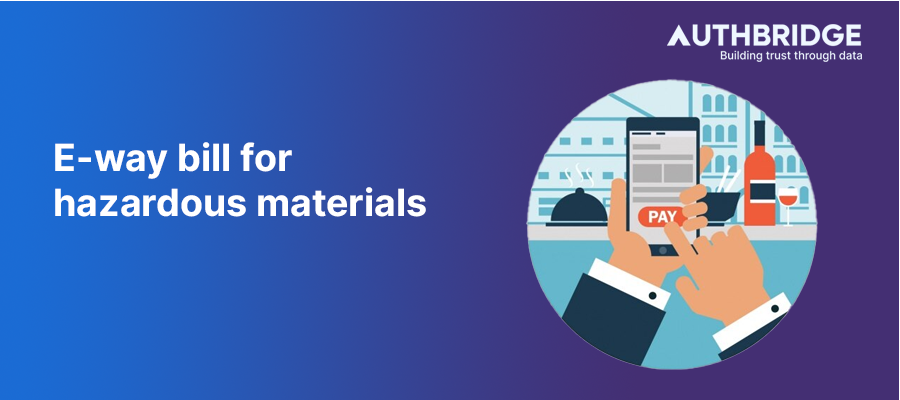E-Way Bill For Hazardous Materials: Essential Guidelines For Compliance And Safety

1. Introduction to E-Way Bill for Hazardous Materials
Definition and Importance
An E-Way Bill is an electronic documentation required for the intra-state and inter-state transportation of goods in India, valued over a certain threshold. For hazardous materials, this document becomes even more crucial due to the potential risks these goods pose to public safety and the environment. It ensures that the transportation of such materials is monitored and complies with the necessary safety standards and regulations.
Legal Framework and Compliance
The requirement for an E-Way Bill for transporting hazardous materials is mandated under the Goods and Services Tax (GST) regime, integrating with the existing regulations under the Environmental Protection Act and rules related to the handling of hazardous materials. Compliance with these regulations is essential to prevent legal repercussions and ensure public safety.
2. Generating E-Way Bill for Hazardous Goods
Pre-Requisites for Generation
To generate an E-Way Bill for hazardous goods, the consignor or consignee must be registered on the E-Way Bill portal. The prerequisites include:
- A valid GST registration number.
- Accurate details of the hazardous material being transported, including HSN code.
- The transporter ID, if a third-party transporter is involved.
Step-by-Step Process
- Login to the E-Way Bill Portal: Use your GST credentials to access the portal.
- Enter Details in Part A: This includes the consignor and consignee's GSTIN, the invoice or bill number, the value of goods, HSN code, and reason for transportation.
- Enter Transporter and Vehicle Details in Part B: For hazardous materials, it's crucial to specify the vehicle type and ensure it's equipped for safe transportation.
- Verification and Submission: Double-check all entered details for accuracy before submission. The portal then generates an E-Way Bill number (EBN) and QR code for ease of verification during transit.
Special Considerations for Hazardous Materials
- Ensure the classification of hazardous goods is accurate according to the Material Safety Data Sheet (MSDS).
- Transportation routes need to be planned considering restricted areas and safety guidelines.
3. Documentation Required for Transporting Hazardous Materials
Mandatory Documents
- E-Way Bill: The generated E-Way Bill number (EBN) must accompany the transported goods.
- Invoice/Bill of Supply: Details of the goods being transported.
- Transporter ID: If a third-party transporter is used, their ID and vehicle number are essential.
- License and Permits: Specific to the type of hazardous material being transported, including state and national permits.
Additional Certifications for Hazardous Goods
- Material Safety Data Sheet (MSDS): Provides detailed information on the handling and storage of hazardous materials.
- Emergency Response Handling Guide: A document outlining the steps to be taken in case of an emergency involving the hazardous goods.
4. Safety Measures and Compliance for Transporting Hazardous Goods
Packaging and Labeling Requirements
Hazardous materials must be packaged according to the specified standards to prevent leaks, spills, or exposure. The packaging must be durable and weather-resistant. Labeling is crucial and must include hazard symbols, handling instructions, and emergency contact information.
Transporter Responsibilities
Transporters must ensure vehicles are equipped to handle hazardous materials safely, including having appropriate containment systems and emergency response equipment. Drivers should be trained in handling hazardous materials and emergency response procedures.
Emergency Response Information
This includes having accessible material safety data sheets (MSDS), emergency contact numbers, and detailed instructions for first responders on handling accidents involving hazardous materials.
5. Penalties and Consequences for Non-Compliance
Fines and Penalties
Non-compliance with E-Way Bill requirements for hazardous materials can result in significant fines and penalties. These can vary based on the nature of the violation but generally include monetary fines and potential confiscation of goods.
Legal Implications
Serious violations can lead to legal action, including criminal charges against the consignor, consignee, or transporter. This underscores the importance of adhering strictly to all regulations governing the transport of hazardous materials.
Conclusion
Transporting hazardous materials requires meticulous attention to detail, adherence to regulations, and a commitment to safety. The E-Way Bill system plays a crucial role in ensuring that these materials are transported legally and safely across India. By following the guidelines outlined in this blog, companies can mitigate risks and ensure compliance with the law.
The integration of data tables in this discussion provides a clear and concise way to present factual and statistical information, enhancing the reader's understanding of the complexities involved in transporting hazardous materials. It's important for all stakeholders, from consignors and consignees to transporters, to stay informed about the latest regulations and best practices in this field.
Category

Abhinandan Banerjee
(Associate Manager - Marketing)
Abhinandan is a dynamic Product and Content Marketer, boasting over seven years of experience in crafting impactful marketing strategies across diverse environments. Known for his strategic insights, he propels digital growth and boosts brand visibility by transforming complex ideas into compelling content that inspires action.



